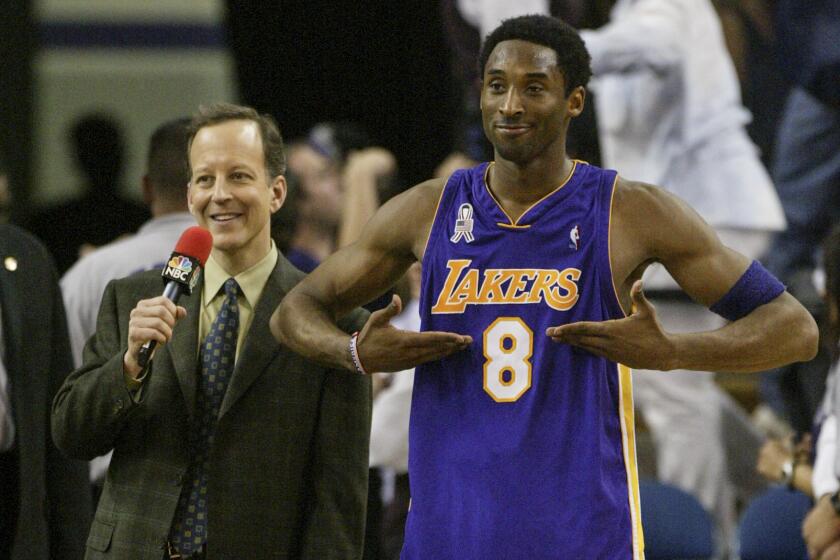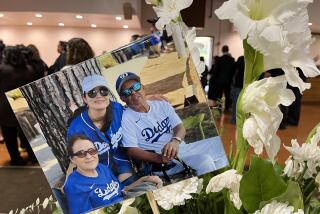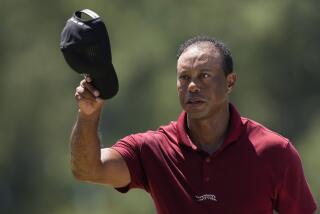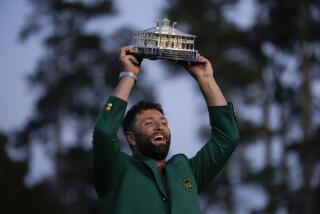Book excerpt: The day Tiger Woods announced himself as a future Masters champ
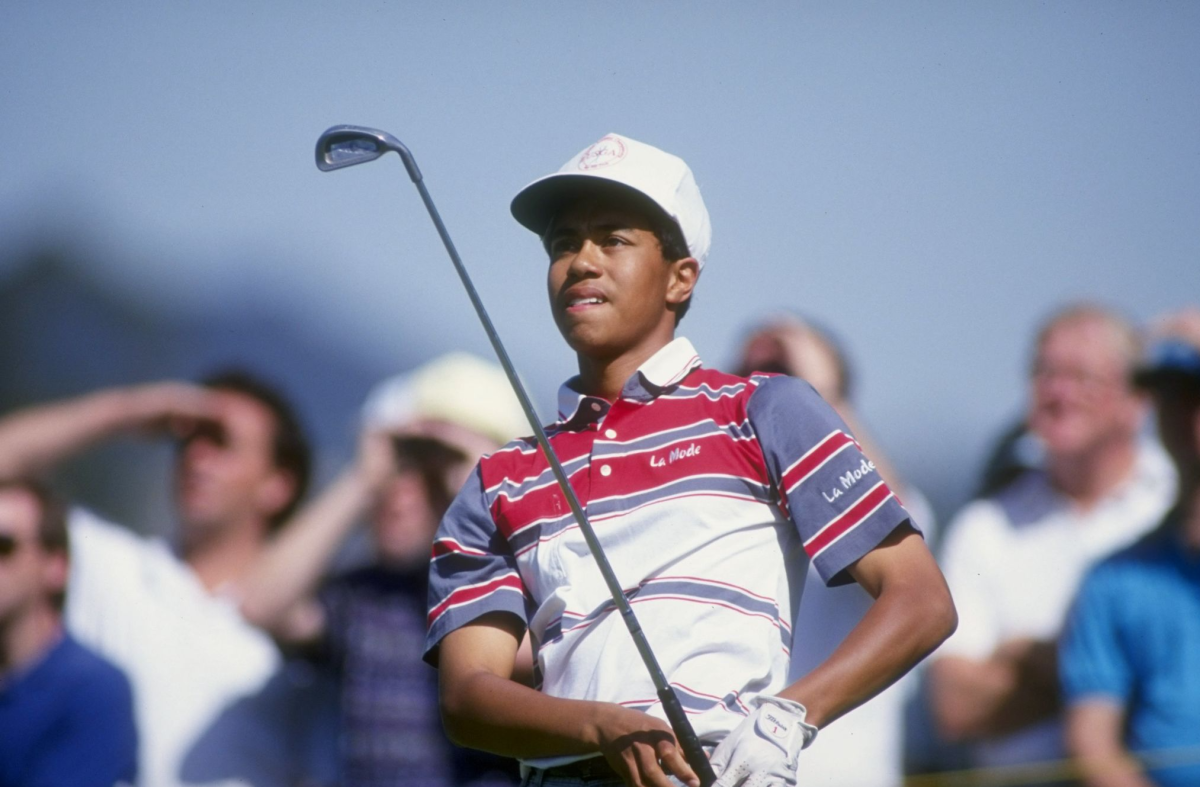
- Share via
This article has been adapted from “Talking to GOATs: The Moments You Remember and the Stories You Never Heard” by Jim Gray, with Greg Bishop. Available from William Morrow, an imprint of HarperCollins Publishers.
I first became aware of a young golf phenom many years ago, while I worked for ESPN as a freelancer in Los Angeles. I was reading the old Herald Examiner, checking out the agate section. Remember those? Small type. One-stop shopping. You could find out who won, who lost, who got hired, who got fired — and all in the same place. On that particular day, I noticed that a nine-year-old named Eldrick Woods had managed to hit a hole in one at a club near his home in Cypress. The item noted that this particular hole in one marked his third total.
That had to be a misprint. I cut the agate box out and placed it carefully on the desk in my office.
Eventually, I called down to Cypress. It wasn’t a misprint.
“Yep, he’s had a few,” said the late John Anselmo, a local teaching pro. “He’s down here every day.”
“Who’s he with?” I asked.
“Comes down here and gets lessons, and he’s with his dad,” Anselmo said. “His dad is teaching him.”
The father was Earl Woods, Anselmo said. And everyone called his son by the same name: Tiger.
I hired my own camera crew and went down to see for myself. I found Earl and asked him if he would let me tape an interview, which might lead to a story. Sure, he said. No problem.
Tiger began to do his thing. He hit something like fifteen balls out of a sand trap and at least four of them rolled right in the hole! Then we went to the driving range. He’s hitting balls, and his dad is giving instructions, and Earl is jingling change and throwing coins at him and Tiger is still crushing drives. One thing that struck me is that Tiger retained the exuberance of a kid, even as he trained and played like an adult. The game came that easy to him. “It’s a fun game, you carry a bag, get good exercise, hit a golf ball, and try and get it into a little hole,” he told me. His father knew that his son was extraordinary, or could be. He said, “He has the talent, and he has the desire, and he has that rare competitiveness, that extra gear, that the great ones have.”
Anselmo, the pro, was equally impressed. He told me, “In all my years of teaching golf I have never seen a boy this age do it and play this well.” At the time Tiger had just finished fourth grade and was one of the top students in his class. He practiced golf twenty hours a week.
As the interview ended, I jokingly asked Tiger if I could be his caddy. He joked back, asking if I could read greens. When I said yes, he said he’d hire me, for the basic 10 percent take that caddies receive from purses. I jokingly accepted on-camera, and we shook hands. Over the years, we’ve laughed about how I should have taken that deal on the spot.
At one point in the segment we shot, which would run on ESPN a few months later, Tiger says, “I think I’m a good golfer, but I need a lot of improvement,” pausing before uttering, “I want to win all of the big tournaments, all of the major ones, and I hope to play well when I get older, and beat all the pros.”
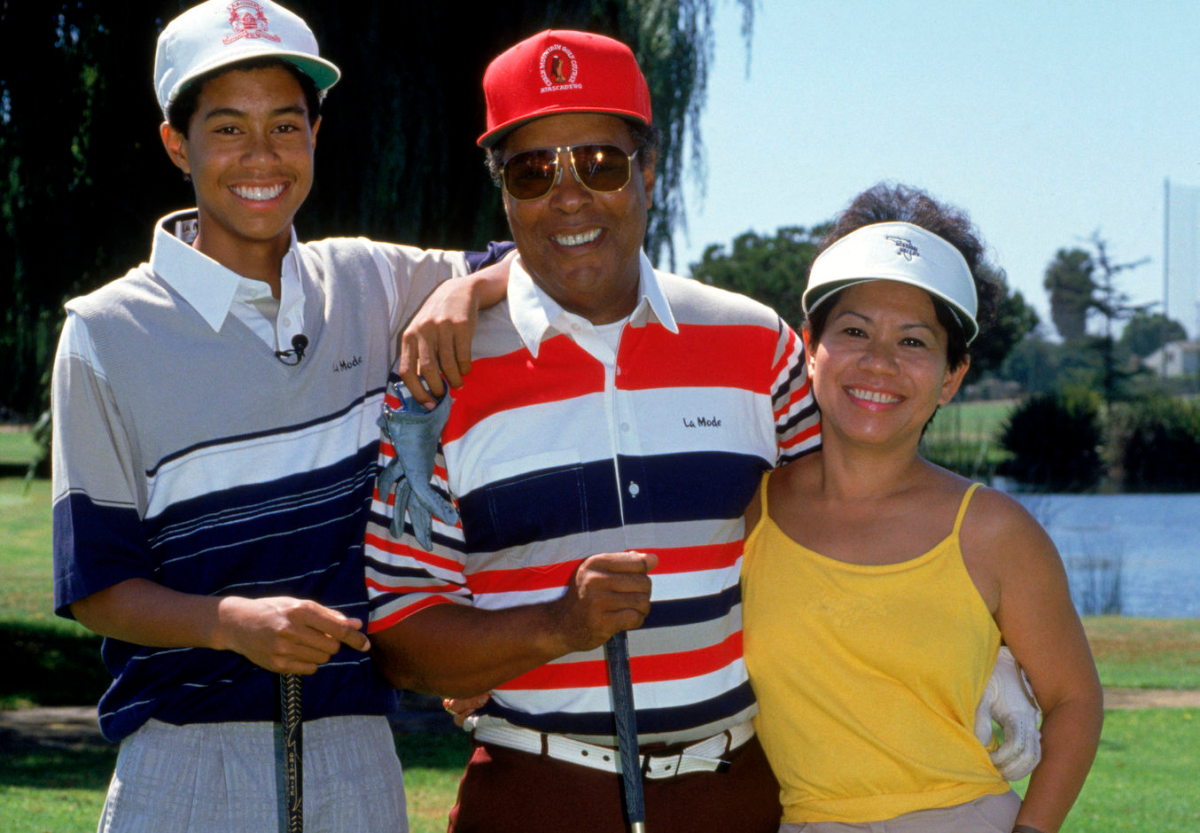
====
Tiger did win all the amateurs, or at least three of them, anyway. He did beat all the pros. Now, I’m not sure anyone saw that he’d win fifteen major championships way back then. Or that he would threaten to surpass Sam Snead’s record total of eighty-two PGA Tour victories, which he tied in 2019.
Still, greatness is greatness. At that level, at his level, it’s unmistakable. You can see it, feel it, sense it, even. I remember one time early in Woods’s career when I interviewed Jack Nicklaus and Arnold Palmer at Augusta National. These are two of the greatest golfers of all time, and they said something like some variation of “This kid’s gonna win more than both of us combined.” I knew Tiger was the real deal when they said that. These aren’t two men who run around making bold proclamations. They were reserved, but they also knew what they were seeing, and they sent out a signal to the rest of the world that Tiger was going to be special.
That was before Woods won the Masters for the first time, in 1997, by an incredible twelve strokes. He was twenty-one years old. Repeating: He was twenty-one years old. It still ranks among my favorite moments, because I knew Tiger as a little kid, because I had seen him coming.
I watched in ’97 as Tiger strode up the eighteenth fairway, toward the green, on the verge of this historic moment. No African American had ever won the Masters, yet the club has a number of employees who are Black. I looked up at the veranda from my vantage point in the radio tower above the green, and I saw so many of the employees who worked in the clubhouse, or on the course, or in security, and they were watching Tiger, witnessing a golfer who was part African American and winning the most storied tournament in golf by the widest of margins. Many of them knew it had only been seven years earlier that Augusta National admitted a Black member, and it would be fifteen more until they would admit a woman. Some of them were in tears. Some of them were laughing and happy, smiles spread wide across their faces. All of them were in disbelief.
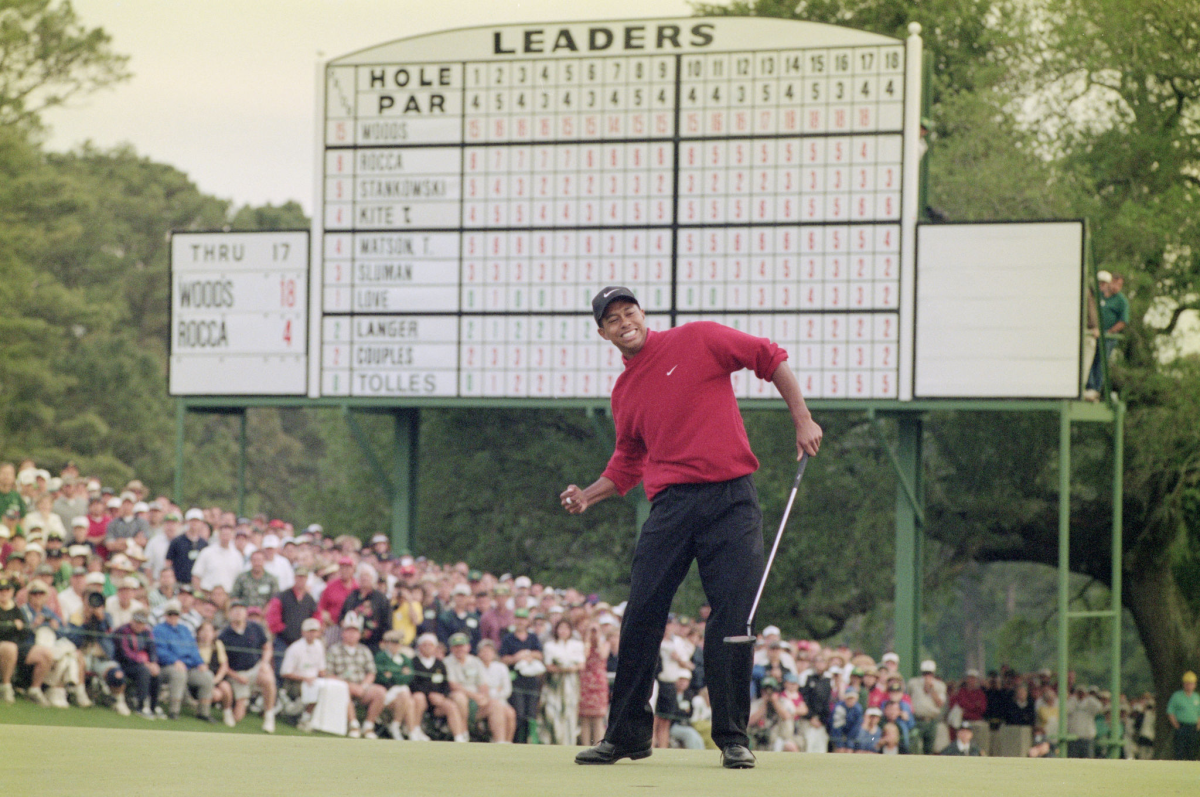
My dad, Jerry, was standing there with me. I’ll never forget how I got to share that moment with him. I can’t remember what we said; just that we were blissful, elated, stunned. We had just seen something historic, something we’d never watched before and something we’d never see again. Jack Nicholson was with us, too. He shared our amazement.
Jack told me something that weekend about fame that has resonated with me ever since. On Friday, we had followed Nicklaus, who was ahead of Tiger on the course. We were walking down the tenth fairway, and Nicholson turned to me, his expression serious.
“Never trust fame,” he said.
His eyes scanned a few holes away at Tiger. “Fame will leave and it’s fleeting, and it will jump away,” he said. “And you can tell that it has to bother Jack Nicklaus, because all of the attention is over here on Tiger.” He wasn’t being critical of Jack Nicklaus the golfer. He was saying: Don’t fall into that trap, don’t put your trust in fame, or your hopes. He was saying: Here’s an example; if you trust fame, you’re in trouble. I could tell he felt empathy for Nicklaus. Perhaps at that moment, Nicholson had taken a glimpse of his own mortality. Time marches on, even for the great ones.
After Tiger won, after the fist pumps and the celebration, he sauntered into Butler Cabin to do the traditional postmatch interview. He did his usual first interview, with Jim Nantz, tugged the famous green jacket on over his shoulders, and then spoke with me for CBS Sports Radio.
Earl Woods came over and shook my hand. Kultida Woods, his mother, mentioned the earlier interview. “We watch that tape all the time,” she said.
===
Fast forward two decades.
At a certain point, I didn’t think Tiger would ever win again. Golf is a psychological game, too. I thought, naturally, that he would be damaged by all that he had endured — the other life he had hid from almost everyone, the marital infidelity and car crash that spread across the internet like wildfire — on top of the physical toll his back, spine, and knee injuries had exacted. When you swing a club that violently all your life, from age three onward or whatever, it will wear down your body over time.
All of which makes his comeback that much more astonishing. Like in September of 2018, when he won the Tour Championship, at East Lake Golf Club in Atlanta, and then, seven months later, when he completed one of the greatest comebacks — from injuries and self-inflicted wounds — in the history of sports. The world wanted Tiger to be great again. At the Masters that spring, on the course where he first announced his greatness, the old Tiger summoned the Tiger of old, roaring and fist-pumping again.
I really didn’t think he would win. I had been told his neck was bothering him. But I didn’t discount him, either. I partook in a friendly dinner bet with Dean Spanos, the Chargers’ owner, where I picked ten players and he got the rest of the Masters field. I knew I couldn’t ignore Tiger Woods at Augusta National, so I included him in my ten picks, despite the misgivings.

I covered the tournament, doing reports for Fox. As Tiger took the lead, then held it, then kept it, I wondered the same thing as the rest of the world, which collectively paused to watch the Masters for the first time since the scandals started. I thought about my dad as Tiger approached the eighteenth green, from where I watched him ascend to sports royalty decades earlier, I thought about the ’97 Masters and our time together and what my friend Jack had said about fame. My father had always loved Tiger, always pulled for him.
I stood behind the green on eighteen, in the media section, behind the ropes. I saw the cautious approach shot, the putt he just missed, the tap in to win the tournament. I saw him celebrate the moment that he himself had doubted would ever occur again. I saw him walk off the green and hug his son. I then saw him wrap his mom in an embrace, the two of them overcome with emotion, and I thought about Earl Woods and wondered if he was up there, looking down.
I believe I’ve witnessed the two greatest comebacks in the history of sports. The first? Super Bowl LI, when the Patriots trailed the Falcons 28–3 and won. The other? Tiger Woods, hands down.
I still see that video sometimes. I still hear his mom, saying, “We watched that tape a million times.” I still remember asking Tiger if I could be his caddy.
From there to here . . . who could have imagined?
More to Read
Go beyond the scoreboard
Get the latest on L.A.'s teams in the daily Sports Report newsletter.
You may occasionally receive promotional content from the Los Angeles Times.
